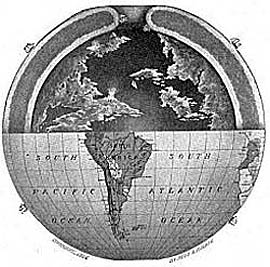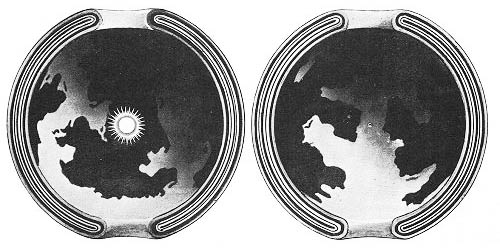Hollow Earth
Today, the Hollow Earth. The University of Houston's College of Engineering presents this series about the machines that make our civilization run, and the people whose ingenuity created them.
I see a rising tide of extreme beliefs around me this winter. Maybe it's the weather; maybe just me. The other day, a passer-by told me with great passion that the space program was a shameless scam. There're no gas stations out there, no air to fly in; the whole thing is clearly staged. Earlier that day, I learned about an Irish company, Stoern Ltd. trying to commercialize its perpetual motion machine. And I hear too many people proclaiming that the Holocaust never took place. Is it something in the water?
Then my son gave me David Standish's book Hollow Earth. Ever since the 17th century, many people, including great scientists, have seriously argued that the earth is hollow. So I read Standish, in hopes that he can put this season in perspective.
He begins with astronomer Halley of Halley's Comet. Halley struggled with two facts: His extensive work on Earth's magnetic field had left him perplexed by the strange meandering of the magnetic poles. And a calculation by his contemporary, Isaac Newton, had shown that the moon was far more dense than Earth. That later proved to be wrong but, at the time, Halley bought it.
So he proposed that Earth is made of three concentric rotating shells and a sphere in the middle -- the inside spaces were filled with a luminous atmosphere and the shells were populated with all sorts of living creatures. The spaces explained why Earth was less dense than we'd expect; the rotating shells explained magnetic variations.
One person who picked up on that idea was Leonhard Euler, the great mathematician of the 18th century. Euler proposed that Earth was completely hollow (no concentric shells) with a six-hundred mile diameter sun in the center. His hollow interior could be reached through holes at the North and South Poles.
Then the American frontier gave us the most visible and insistent Hollow Earth promoter. Captain John Symmes, born in 1780, became a hero in the War of 1812. After that he moved west and traded goods around St. Louis. There he plunged into his advocacy of a hollow earth with Halley's concentric spheres and Euler's holes.
Symmes tried to talk congress into funding an expedition to find the Antarctic hole into the center of Earth. He failed, but he did pick up an enthusiastic disciple, Jeremiah Reynolds. When Symmes died at the early age of 48, Reynolds took up the cause. In 1829, Reynolds managed to raise enough money for an Antarctic voyage.
It yielded nothing, of course; but it took more than defeat to squash Reynolds. He traveled, lectured -- even engaged Edgar Allan Poe as an ally. Hollow Earth remained alive and well, flitting between literature and pseudoscience. Baudelaire was interested. Jules Verne and Edgar Rice Burroughs made hay with the idea.
By the time I was reading about Hollow Earth in Amazing Stories Magazine, the idea was pretty well limited to science fiction. But the impulse to believe Anything-Strange is, alas, intact. And, this year, that impulse has had quite a season indeed.
I'm John Lienhard, at the University of Houston, where we're interested in the way inventive minds work.
D. Standish, Hollow Earth: the Long and Curious History of Imagining Strange Lands, Fantastical Creatures, Advanced Civilizations, and Marvelous Machines below the Earth's Surface. (Cambridge, MA: Da Capo Press, 2006). (My thanks to Andrew Lienhard for this source.)
For a brief history of Hollow Earth online, see: http://www.unmuseum.org/hollow.htm
Google "Hollow Earth" and you'll find countless contemporary advocates.


Left: image of Symmes' Hollow Earth published long after his death by his son, Americus Symmes. Right: William Reed's published image from 1906.
Below, image from Marshall B. Gardiner, A Journey to Earth's Center. 1920.
